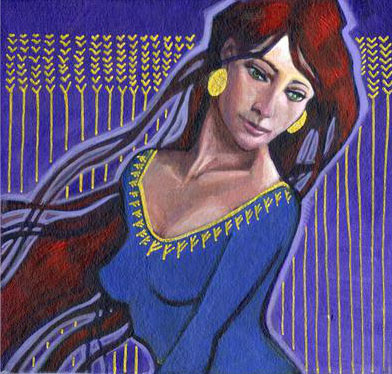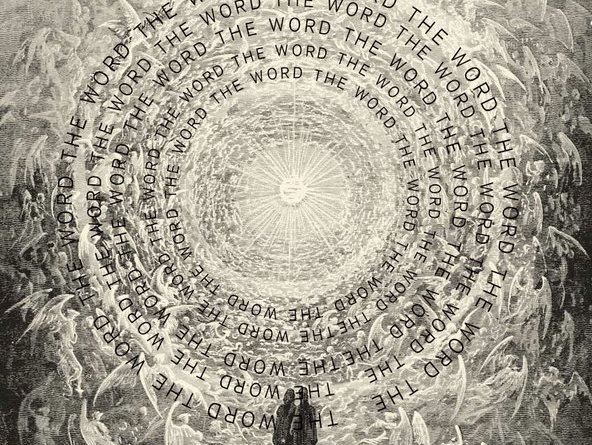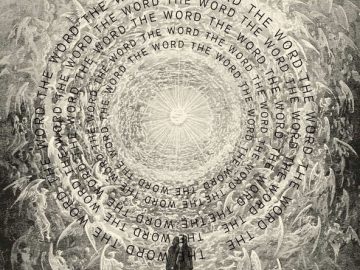by Martin Pulido

As part of the A Mother Here Art and Poetry Contest, I have been trying to highlight historical and contemporary artists that have already portrayed or referred to Heavenly Mother in their works. This is Part 2 in a series discussing Heavenly Mother in the life and poetry of Melody Newey. For Part 1, go here.
PULIDO: This notion of the word and art being a conduit by which heaven spills into the earth is an interesting image. It makes art essentially revelatory. This leads me to another thought and question, so bear with me here. It’s been my observation of our current Mormon culture that we haven’t put a large emphasis on art. I’ve read articles speaking roughly to this effect, and you can see it in the plainness of our chapels, and the excessively repetitious artwork adorning the hallways of our meetinghouses.
A stake center I used to attend in southern Utah had the exact same piece of art on opposite sides of the building, and I thought “Really? They can’t have any more variety than this?” For a religion that proudly professes belief in continuing revelation, we seem to stifle the revelatory expression embedded in art. Am I wrong here? What do you think about this?
NEWEY: I think you’re right — We have correlated art out of us; it breaks my heart. It’s ironic, really. In trying to establish a uniform model for worship we have gotten rid of some of the very things that create the best environment for worship. This model is highly structured, uniform and rigid, in contrast to our freeflowing, natural experience and expressions of spirit. Worship is an expression of the soul. I go to a Mormon feminist retreat in Denver each year, and this last year Fiona Givens said that we Mormons don’t worship anymore. We just go to meetings. The lack of art in our buildings is an expression of that lack of worship, or it at least it’s contributed to a less worshipful experience for me.
But I’m hopeful; I think we’ve become dissatisfied with the current situation. We’re trying to swing the pendulum back towards something better that we have lost or at least never fully expressed, since I think art was valued quite a bit in the early church. The A Mother Here art contest is an example of that push.
PULIDO: Thanks, I’d like to think that the contest is doing that. I’ve taken us off track a little bit, so let me see if I can redirect this conversation. How do you go about writing your own poetry? For instance, do you outline your structure and fill it in slowly as you tease out the right words, or do you write freely and then adjust the result until it pleases you? Or perhaps you do something else entirely–like pull words out of a hat!
NEWEY: Free verse-R-us. I typically just start writing and see what comes. Sometimes a poem comes out fully formed – thematically, artistically perfect. I love those times. That used to happen a lot because I have a penchant for brevity. For me, poetry is truth-telling. It always has been. And I feel there is a strong relationship between truth and brevity. So, a large portion of my poetry is what one friend called the equivalent of Japanese art: simple, uncluttered, yet beautiful. These are sometimes the most profound of my poems.
However, as I’ve grown up as a poet, I’ve learned to expand ideas and re-write, review, revise more than I used to. The over-all process varies day to day, so it’s difficult for me to really describe it. But basically I write a poem out and see how it goes. After the poem is on the page, I will often look at it and see what structure has emerged and then try to make it better with a few revisions. Then I rest from it for a month or so, and then I read it again with new eyes, and see if there is anything else that needs to be fixed.
PULIDO: Alright, I think we’ve learned a good bit about you as a poet. Can you tell us when you first started writing about Heavenly Mother? Were there are any events in your life going on then that inspired you to write about Her?
NEWEY: Returning to that time of my life at twenty-five when the poetry-spill started – much of the trauma I endured in childhood was perpetrated by men, including my father. So, my relationship with Heavenly Father became problematic for a time. Amazingly, my relationship with Christ was unaltered and it was through that relationship I first felt stirrings of awareness about Heavenly Mother. Which makes complete sense to me because if Christ is our advocate with the Father, then surely he is also our advocate with the Mother. If “No man cometh unto the Father but by [Christ],” then no man or woman comes to the Mother without Him (John 14:6). Christ is the mortal representation of God, the divine being to whom we look in order to find our way home to God the Father and God the Mother.
Also important here, not long after this time (the late 80’s to early 90’s) Carol Lynn Pearson wrote and performed Mother Wove the Morning. I saw her perform this twice and her testimony via her art really touched me. Carol’s vocal affirmation and expression of the divine feminine gave me permission to open up to what had already begun budding in my own heart – the truth that I have a Mother there. And we all owe an enormous debt to Eliza R Snow for getting Heavenly Mother into the hymn book.
When I have written about Heavenly Mother, it has come about unexpectedly. “Missing God” was my first poem where I specifically wrote about Heavenly Mother. I wrote that short poem in the early 90’s while sitting at the base of Bridal Veil Falls, a place I would often visit. This time it was on a day when no one else was there, which was kind of odd, since there are usually a lot of people there during at mid-morning. I was sitting on the grass at the base of the falls, across from the trail, when the poem came completely unexpected. It was very clearly and undeniably a whispering about a Heavenly Mother; a divine woman. I had had a vague feeling of the divine feminine before, but no personal witness of Her presence until that day. I had connected to Heavenly Mother while coping with my childhood trauma; and there had been a period of time when I couldn’t connect with Heavenly Father. But this was my first experience, very clearly feminine, and I wrote it down in “Missing God.”
Fae Ellsworth, one of my artist friends, worked on creating some collaborative work with me for the 2002 Winter Olympics, and “Missing God” ended up being one of the poems that she created a visual arts piece to represent. The pastel piece shows a mountainous region of Southern Utah and a subtle profile of a woman playing a flute.
PULIDO: That’s great. I hope to see the art accompanying “Missing God” someday. I noticed that you said your writing about Heavenly Mother comes about unexpectedly, so now I want to know more. What brought about “Heavenly Mother Sings”?
NEWEY: I wrote that poem for the Rational Faith blog’s wonderful Heavenly Mother series. I wrote for Rational Faith for about a year after they invited me to do so, and since I was the “resident poet” I felt like I should write something about Heavenly Mother. The idea for the poem came to me while I was among nature again, not at Bridal Veil Falls, but at work in my own garden. So again, very sudden.
PULIDO: Any other instances of Her sudden appearance?
NEWEY: Yes. Sometimes I get sick of feminist writing, even though I am a stalwart Mormon feminist. The dialogue sometimes feels too insular, too focused on women. For instance: babies are here because a man and woman were brought together, usually out of love. I recently wrote a poem for a friend of mine, regarding the birth of a child. The poem had a man and a woman in it because I felt it needed this focus on Man and Woman. Then Heavenly Mother also appeared – God the Mother was giving Her blessing to a woman giving birth to a daughter. She presented Herself regardless of what my original intention was. It was totally unexpected.
PULIDO: I am curious. What are some of the challenges of trying to write to or about Heavenly Mother in your work? Are they different from the challenges of trying to portray the divine in general–such as is manifest in Father, Son, or Holy Ghost?

NEWEY: As with any poem, I’m writing my experience. I think it’s an act of profound presumptuousness and or perhaps childlike faith to try to portray any form of God through art. Yet, we do it all the time. In many ways God – Mother, Father, Son, Holy Spirit – are ineffable, incomprehensible, and yet, because the LDS faith is rooted in the ideology “As woman is, God once was. As God is, woman may become” we continue to approach her through art.
Most of us don’t have very concrete experiences of God—very rarely do we have visual or tactile experiences with divinity. So I don’t visualize or understand the Father any better than the Mother. Christ I can define; I can read the written records to learn about who He was and is. But I think it’s strange that we talk about God the Father so much that we make the assumption we know something about him. But we know hardly any more about him than we do about Heavenly Mother.
While there’s not any great difference in trying to write about one divine person over another, when writing about Heavenly Mother, it feels more… the word “Genesis” comes to my mind. It feels more generative and truly original since there is so little out there. It feels brand new, not really touched before.
PULIDO: Right. There’s so little tradition in the writing to really reference and be in dialogue with. It’s even truer in the visual arts. There’s no existing iconography about Heavenly Mother. Heavenly Father is the old guy in a white robe with a big white beard and who shines lots of light, and Mary is a beautiful young woman wearing a large blue shawl–or blue dress–or blue something, often carrying a baby.
NEWEY: Yes, there’s a sense that I’m breaking new ground. There’s a freedom to it. When I sit and ask, what I shall write about, I ask myself, “How has Heavenly Mother presented Herself to me? What is Heavenly Mother really?” What comes about is quite a variety of approaches. She’s God, all powerful. A powerful woman. She is also lovely and motherly. I feel there is this universal soup that is percolating, a “female energy” seeking for balance in the world. My poems about Heavenly Mother feel like they come partly from that soup.
This concludes part 2. In part 3, we will dig into the evolution of Melody’s treatment of Heavenly Mother in her poems, discuss the relationship between God and nature, and her constant incorporation of Christ when mentioning the Mother.
Martin Pulido is a businessman by day, LDS scholar by night, who has extensively researched Mormon belief in a Heavenly Mother. He co-authored the BYU Studies article, “A Mother There: A Survey of Historical Teachings about Mother in Heaven,” with David Paulsen, and has organized the A Mother Here Art and Poetry Contest with Caroline Kline. The “A Mother Here Art and Poetry Contest” is looking for 2-dimensional visual arts pieces and poems that portray Heavenly Mother. The contest will accept entries up until March 4, 2014, and over $2200 in prizes will be awarded when the best entries are announced on May 11, 2014. For more details, visit www.amotherhere.com. The contest is being sponsored by Exponent II, Dialogue: A Journal of Mormon Thought, Sunstone, Peculiar Pages, LDS WAVE, and Segullah.






9 Responses
Melody…you are amazing!
Thanks, friend!
[…] concludes part 1. In the next part, we learn about how Melody goes about writing poetry, and begin the discussion of her treatment of […]
Wow, what a fantastic conversation. I love your thoughts on Heavenly Mother, Melody. So much of what you write about HM — like your experience of finding her through Christ — strikes me as important and unique Mormon feminist theological ideas. Awesome.
Caroline, it was in Gospel Doctrine class that the thought first occurred to me “He is our advocate with the Mother.” How can it be otherwise if the father and the mother are One? It feels right for me, anyway. And hurray for LDS Feminist Theology! It’s my favorite.
I think this is an important item as we move forward with trying to incorporate Heavenly Mother more into our Mormon faith and art. That we think of Heavenly Mother not at the expense of Christ, who is Her image and Her gift to us. We will understood Her better when we study the life of Her Son. We might want to demand as the disciples of old, “Show us the Mother!” And the appropriate response might be, “He (or she) that hath seen me, hath seen the Mother.” We don’t want to neglect what She has given us to understand Her best. This of course is not to throw out other avenues of thought and approaches, but to encourage us to remember what should be at the forefront of our considerations.
[…] As part of the A Mother Here Art and Poetry Contest, I have been trying to highlight historical and contemporary artists that have already portrayed or referred to Heavenly Mother in their works. This is Part 3 in a series discussing Heavenly Mother in the life and poetry of Melody Newey. For Part 1, go here; for Part 2, here. […]
Well said in your comment above, Martin. I want to add that I completely agree with you. Because each of us is unique, we come to know God, (as we understand Him/Her) in our own way and in our own time. Because my God is Christ and his parents, this is how I am finding, as a Mormon woman, the true nature of God.
I didn’t state this in our interview, but I’d like to mention here that I honor and respect every person’s individual experience of God. This is paramount in my mind – that I cannot define God for you or anyone else. I can only share my experience and you can choose to see either truth or error therein. Thank you for your wonderful comments – here and elsewhere.
Yes, it reminds me of the second chapter of Janice Allred’s book “God the Mother”, which is an essay entitled “Jesus our Mother”, and discusses how Jesus is both a model for women and women and a revelation of the Mother as well as the Father.
I also deeply appreciated the power of your simple rephrasing of the Snow couplet. Just powerful seeing those words.